TIME: 2022-12-20
1、 Introduction to Submarine Pipeline Engineering
In today's world, countries are focusing on the development of marine oil and gas resources in offshore oil, which requires the construction of various oil production platforms, drilling, and oil and gas resource transportation facilities at sea. Currently, countries use submarine pipelines as the main transportation method for marine oil and gas resources. Therefore, submarine pipelines have become an important component of offshore oil and gas field development, with advantages such as convenience, reliability, economy, and efficiency, and are the main means of oil and gas export.
Submarine oil and gas transmission pipelines refer to the part of pipelines with a diameter of 20cm to 1m located below the sea surface when the water level is highest. They are the main mode of oil and gas transmission in offshore oil and gas field development, also known as the "lifeline" in offshore oil and gas production systems. China's underwater oil and gas pipelines have developed in the past 20 years. According to statistics, the submarine oil and gas pipeline built in China in 2005 has a total length of over 3000km. This project has formed proprietary technical capabilities with Chinese offshore characteristics, and has enabled engineering and technical personnel to basically master the construction design and technology of submarine oil and gas pipelines within a water depth of 100 meters. At present, the total length of China's underwater pipelines has exceeded 9000km, of which nearly 8000km belongs to China National Offshore Oil Corporation (CNOOC). China's submarine pipelines account for about 5% of the total length of oil and gas pipelines in the country. Although their proportion is not high, their transportation volume is close to 25% of the total oil and gas transportation volume in the country.
Internationally, submarine pipelines originated in the Gulf of Mexico in the United States, and the world's first submarine pipeline was built in 1954. Up to now, submarine pipelines have achieved a leapfrog development from shallow waters to shallow waters, and then to medium, deep, and ultra deep waters. In the early days, the pipeline form was mainly composed of steel pipes, and then shifted to a combination of various types, including single-layer steel pipes, double-layer insulation steel pipes, single-layer jacket insulation steel pipes, internal alloy steel pipes, parent-child binding pipes, flexible pipes, bonded non-metallic pipes, bundle pipes, etc. According to their usage location and status, submarine pipelines can be further divided into floating pipelines on the sea surface, vertical pipelines in water, horizontal pipelines on the seabed, and dynamic risers. At present, the deepest underwater pipeline in the world has been laid at a depth of over 2824 meters.
The research on submarine pipeline related technologies in China started relatively late, and due to technological blockades and outdated equipment, the development of the submarine pipeline engineering industry is greatly limited. In 1973, China's first underwater oil and gas pipeline was successfully laid in Huangdao, Shandong; In 1985, China's first underwater oil and gas pipeline between offshore platforms was completed and put into operation in the Chengbei Oilfield; In 1989, China independently built its first submarine pipeline in the Bozhong 28-1 oilfield, truly possessing the engineering and technical capabilities of submarine pipelines. In recent years, with the increase of China's independent research and development efforts and the acceleration of the development and construction of offshore oil and gas fields, China has comprehensively created and formed an underwater pipeline engineering system.
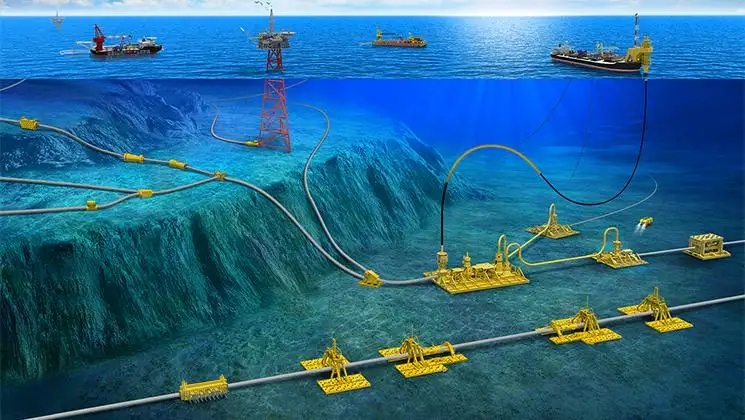
Submarine pipelines can be divided into internal transfer platforms, pipelines, and external water, connecting pipelines, or chemical transportation pipelines based on their intended use. The laying status of submarine pipelines includes three forms: trenching without burying pipelines, laying pipelines flat on the seabed, and trenching shallow buried pipelines. The operation status of submarine pipelines includes not only the laying status mentioned above, but also the suspended state caused by waves, terrain, ocean currents, and erosion. The current research on submarine pipeline engineering in China mainly includes pipeline construction technology, safety status evaluation of submarine pipelines, and fatigue life analysis and evaluation of pipelines.
At present, China has independently mastered a series of core key technologies, including long-distance multiphase transportation technology for heavy oil and high pour point crude oil in ocean pipelines, design technology for submarine oil and gas pipelines under harsh sea conditions and complex landforms, efficient installation technology for submarine pipelines, emergency response and maintenance technology for submarine pipeline accidents, and has established a relatively complete engineering equipment system, effectively solving a series of major problems such as multiphase transportation of heavy oil and high pour point crude oil in China's ocean, design, installation, maintenance and repair of submarine pipelines under harsh sea conditions and complex geology. The Bohai Sea, East China Sea, and South China Sea marine oil and gas pipelines have been built, supporting the construction of China's "offshore Daqing".
2、 Method of laying submarine pipelines
1. Pipe laying vessel method
(1) Dragging method
The dragging method is generally applied to the laying of submarine pipelines in shallow waters near the sea. The pipeline in the towing method is generally assembled into a specified length on land or on a laying ship in shallow sheltered waters. Then, the pipeline is lifted onto the launching track using a lifting device, and the towing head is tied to the buoy. The pipeline is then towed into the water using a towing boat, and the pipeline is positioned and sunk according to the predetermined route. Finally, each section of the pipeline is connected to complete the entire process of pipeline laying. At present, there are four types of towing methods: floating towing, underwater towing, off bottom towing, and bottom towing.
① Floating trailer. Floating tugs are mainly used in sea areas with low wind and waves. They refer to the use of buoys to adjust the buoyancy of pipelines to float on the water surface, and then use a high-power main tugboat to tow the head end of the pipeline along a predetermined route. The tail tugboat pulls the tail end of the pipeline to control its lateral drift to ensure pipeline safety. It is limited by factors such as seawater flow rate, pipeline size, and tugboat size, and the length of the pipeline for each float varies from a few hundred to several thousand meters.
③ Towing underwater. The underwater towing method is somewhat similar to the floating towing method, except that the pipeline position is adjusted to a certain depth below the water surface for towing. Moreover, the pipeline dragged under the water surface is less directly affected by environmental loads such as waves and wind, making the pipeline safer.
③ Pull off the bottom. Off bottom towing refers to the use of drag chains and buoys to suspend pipelines above the seabed at a certain height, and then being towed forward by surface tugboats. This avoids seabed obstacles and terrain undulations, while reducing the impact of sea surface winds and waves. Therefore, this method has a wide range of applications.
④ Bottom drag. In bottom towing, the pipeline is directly placed on the seabed and towed by surface tugboats to the placement site. This type of construction method is relatively simple, but it is also affected by the type of soil on the seabed and the undulations of the seabed terrain. It requires a relatively large tugboat horsepower, short pipeline length and towing distance, and is generally only applied in flat sea areas. The specific method is shown in Figure 1.
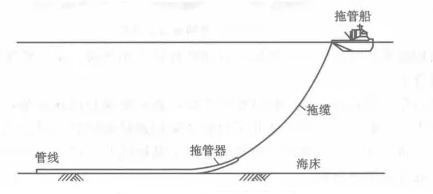
Figure 1 Schematic diagram of bottom dragging method for pipe laying
⑵ S-shaped pipe laying method
At present, the most commonly used method in submarine pipeline laying technology is the S-shaped laying method. This method generally requires the arrangement of anchor tugboats or multiple anchor tugboats to support the laying of pipelines. Before the project starts, an anchor needs to be positioned on the seabed, and then the anchor cable is led through the stinger and tied to the port of the first pipe. With the support of the stinger, it will naturally bend into an S-shaped curve. As shown in Figure 2. According to the different force points, it can be divided into three regions, namely the upper bending section, the middle section, and the lower bending section. The upper bend section generally extends downwards from the tensioner on the laying vessel until the pipeline is detached from the support of the stinger; The lower bend section is the area from the turning point to the landing point of the pipeline on the seabed mud surface; The middle section is generally shorter, which is the part between the upper and lower bending sections. At present, S-shaped pipe laying technology can use multiple operation lines for pipeline prefabrication, requiring a stinger with multiple welding stations. As the water depth increases, the length of the stinger will increase and the tension will also increase, but its stability will be weakened and the risk will also increase.
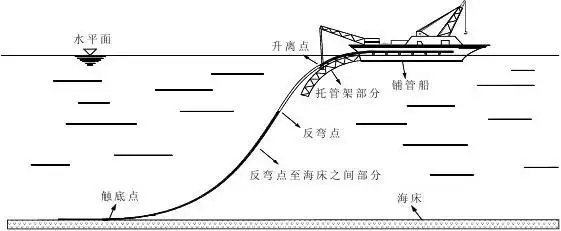
Figure 2 Schematic diagram of S-shaped pipe laying method
⑶ J-shaped pipe laying method
In order to adapt to the continuous increase in pipe laying depth, the J-shaped pipe laying method has been developed since the 1980s, and it is the most suitable method for laying deep-sea and ultra deep underwater pipelines. At present, there are two main types of J-type pipe laying method: drilling vessel J-type pipe laying method and J-type pipe laying method with inclined slide. During the laying process, the tension borne by adjusting the pipeline and inclination angle of the stinger is used to improve the stress state of the suspended pipeline, achieving the goal of safe construction, as shown in Figure 3.
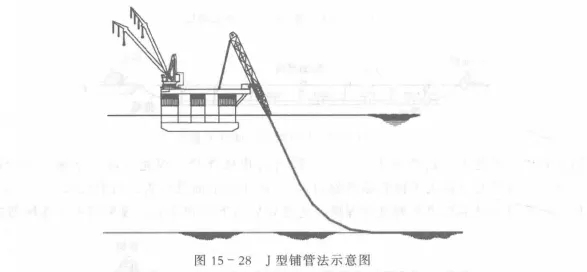
Figure 3 Schematic diagram of J-shaped pipe laying method
(4) Rolling pipe laying method
The roll pipe laying method has high efficiency and low cost. It is a method of lengthening pipelines in land prefabrication sites, rolling them onto dedicated drums, and then sending them to the sea for laying. It has low engineering risk and can be laid continuously. Due to the limitations of the size of the laying vessel and the diameter of the drum, the roll pipe laying method is suitable for flexible small diameter pipelines and is suitable for laying pipelines in deep water areas. There are generally two methods for placing the drum in the coil method: horizontal placement and vertical placement. In order to reduce the plastic deformation of the pipeline after winding, the diameter of the drum is generally larger. As shown in Figure 4.

Figure 4 Schematic diagram of coiled pipe laying method
2. Dragging method pipe laying technology
The onshore towing method is divided into two types: the takeover towing method and the abandonment towing method. The takeover towing method refers to the laying ship placing the pipeline on the axis, and then sending one end of the land winch towing rigging to the laying ship to connect it with the pipeline towing head. Then, using the engineering line on the laying ship to takeover, the land winch towing the pipeline one by one, and gradually dragging the pipeline towards the landing point; The abandonment method refers to the process of laying a normal section of pipe after the laying vessel is in place, and then abandoning the pipe after it reaches the length of the designed section. The land winch pulls the pipeline to the shore, and the winch of the laying ship immediately releases the cable. When the end of the pipeline is about to reach the initial position of the original laying ship, the towing should be stopped. The laying ship begins to move back to the ship and retracts the end of the pipeline to continue taking over, abandoning, and taking over again. This method is used to complete the landing and laying of the pipeline. As shown in Figure 5.
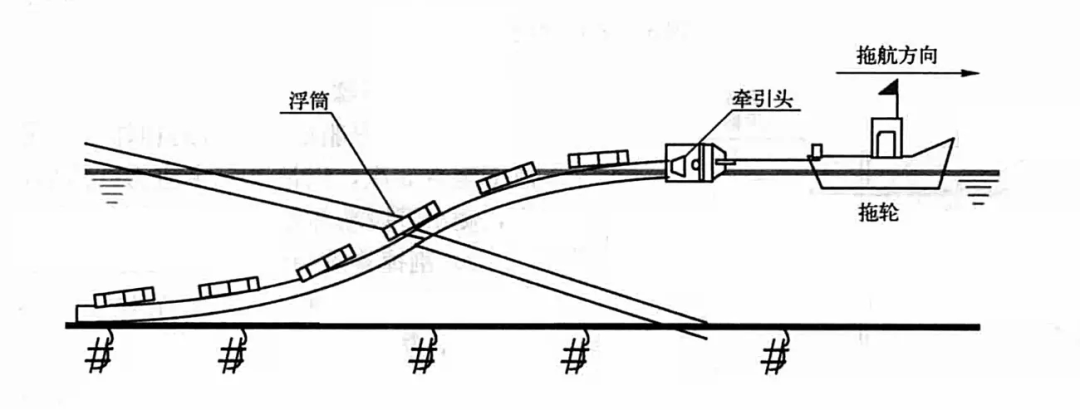
Figure 5 Schematic diagram of underwater pipeline towing
3. Planktonic method
Floating method pipeline laying refers to the completion of pipeline connections on a laying vessel in shallow sheltered waters or on the road. The pipeline is laid by using a float to float on the water surface, and then being towed by an engineering ship to the designed route of the pipeline. The float is lifted to allow the pipeline to sink to the seabed. This laying method is affected by the waves on the sea surface, and in order to control the floating pipeline, a restraining tugboat is also needed. The method of laying pipelines by floating on or near the water surface is easily affected by the water surface conditions, thereby affecting maritime traffic.
Stability is one of the key issues in submarine pipeline design. According to statistics, with the continuous increase in global energy demand and technological progress in recent decades, offshore oil and gas are also constantly being developed into deep water. In terms of the main deepwater pipeline laying engineering methods used between 1996 and 2006, out of a total of 64 projects, 32 projects adopted the S-shaped pipeline laying method, accounting for 5000 of the total, and the J-shaped pipeline laying method accounted for 58% of the total. These data fully indicate that the S-shaped pipeline laying method is still the most important deepwater pipeline laying method in Haiti's pipeline laying technology. With the continuous progress of submarine pipeline laying equipment and laying technology in recent years, the depth of the S-shaped pipeline laying method has also increased. Continuously increasing.
3、 The Development History of China's Submarine Pipeline Industry
1. Development stage
The development process of China's underwater pipeline industry can be divided into the following five stages.
(1) Sprouting period (1965-1980): Embarking on local methods and exploring the sea. With onshore technology and equipment as the backbone, we are moving towards the ocean. Through self-reliance, continuous learning and experimentation, we have achieved a breakthrough for the first time from land to sea, and from shore to ship to beach. The installation technology of planktonic method in shallow waters has been successfully applied for the first time.
⑵ Growth period (1980-1989): Foreign cooperation, learning and borrowing. By adopting international standards and relying on foreign cooperation such as China, Japan, and France in oilfield development, we have overcome technical challenges such as internal pressure, external corrosion resistance, waterproof sealing, and resistance to wind and wave environments in shallow water submarine pipelines. Significant progress and breakthroughs have been made in submarine pipeline engineering technology, achieving pipeline oil and gas gathering and transportation, as well as structural safety in shallow water areas. The engineering design water depth is 0-30m.
Development period (1990-2006): Self construction and comprehensive improvement. The design, installation, and maintenance capabilities of submarine pipeline engineering continue to improve, fully developing shallow water submarine pipeline technology, and initially constructing a submarine pipeline engineering system that is suitable for China's environment and geological characteristics, achieving safe underwater gathering and transportation of multiple and complex pipeline transportation media. More than 100 submarine pipeline projects with a cumulative mileage of about 3000km have been constructed, with a designed water depth of 0-150m.
Development period (2006-2014): Gradually breaking away from external dependence and achieving diversified development. The technological and equipment capabilities have been greatly improved, and breakthroughs have been made in the installation, stability, laying, hoisting, and pre commissioning of submarine pipelines in medium and deep water areas. A complete underwater pipeline engineering equipment system has been established with a water depth of less than 300m. Breaking through major technical challenges such as high static water pressure resistance, passing through gullies, resisting high-strength fatigue loads, and ensuring deep water flow, we have successfully built the "Offshore Daqing". We have a preliminary reserve of 1500m deep-water engineering technology capabilities and have achieved diversified engineering construction, including steel offshore pipes, internal alloy pipes, sub and sub tie pipes, and flexible pipes.
(5) Crossing period (after 2014): China has widely participated in the competition in the international submarine pipeline engineering market. Establish a deep-water submarine pipeline engineering technology and equipment system that integrates design, construction, installation, and maintenance, and continuously improve China's shallow and medium deep-water submarine pipeline engineering technology system. Fully possessing the technical capability for independent construction of 1500m ultra deep water oil and gas pipelines, the "Deep Sea No.1" atmospheric field has been built and successfully put into operation (Figure 6), and the overall technical and equipment capabilities have reached the international advanced level.
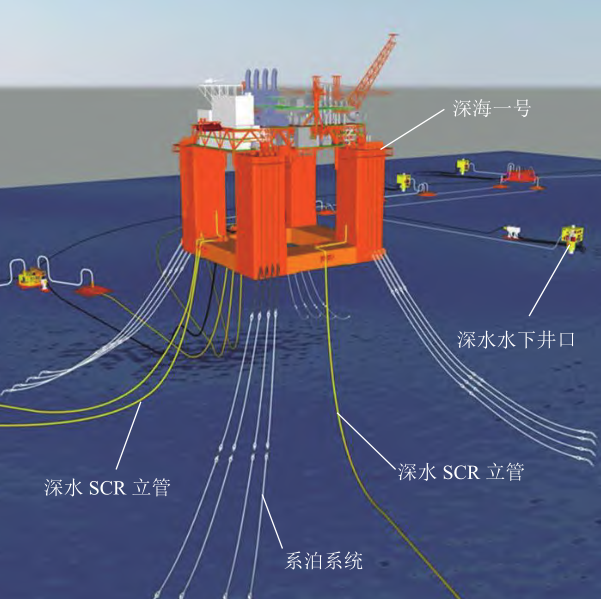
Figure 6 "Deep Sea One" Energy Station and Deep Water Riser Model Diagram
In 1989, China independently constructed its first 1.6km long, 6-inch (1in=2.54cm) mixed transport submarine pipeline in the Bozhong 28-1 oilfield, accelerating the process of localization and localization of submarine pipeline engineering, technology, materials, and equipment. In 1992, China's first long-distance oil, gas, and water mixed transportation submarine pipeline with a length of 48.6km and a diameter of 12 inches was built in the Jinzhou 20-2 oil and gas field. In the same year, China's first bundled "sub main pipe" submarine pipeline with a diameter of 2 inches/8 inches and a length of 10.3 km was successfully put into operation in the Jinzhou 20-2 oil and gas field. In 1995, a natural gas transmission submarine pipeline with a diameter of 28 inches and a total length of 778 km was built in the Yacheng 13-1 gas field, which is the longest in China. In 1998, China's longest multiphase mixed transportation submarine pipeline was completed and put into operation in Pinghu Oil and Gas Field. The submarine pipeline has a diameter of 14 inches and a total length of 366km.
In 2001, China's first long-distance heavy oil mixed transportation submarine pipeline with a total length of 70km and a diameter of 20in was built in the Suizhong 36-1 oil and gas field, which is also the world's longest heavy oil mixed transportation submarine pipeline. In 2006, China's first domestically produced seamless submarine pipeline was completed and put into operation. In 2007, the first high-frequency resistance welding submarine pipeline in Wenchang Oilfield Group was domestically produced, and the first domestically produced submerged arc welded submarine oil and gas pipeline was built in Panyu/Huizhou oil and gas fields. In 2009, China's first skin effect electric heat tracing hybrid submarine pipeline with a diameter of 10 inches and a length of 33.5 kilometers was put into operation in the Bonan oil and gas field. In 2010, China's first domestically produced flexible marine hose with a diameter of 6 inches and a length of 4.2 kilometers was completed and put into operation in the Weizhou 6-8 oilfield. In 2013, China's first corrosion-resistant alloy submarine pipeline with a diameter of 6 inches and a length of 22.5 kilometers was successfully built in the Yacheng 13-4 oil and gas field. In 2014, China's largest high-pressure large-diameter deep-water submarine pipeline with the highest elevation difference was completed and put into operation in the Liwan 3-1 oil and gas field. Its diameter is 22 inches, length is 79 km, and maximum design elevation difference is 1409 meters. In 2019, the longest submarine pipeline independently laid by China was built in the Dongfang 13-2 oil and gas field, with a diameter of 24 inches and a length of 195km. In 2021, China's first ultra deep water marine riser was put into operation in the Deep Sea No.1 Atmospheric Field, with a diameter of 10 inches and a maximum depth of 1463 meters. At the same time, the largest underwater pipeline in China with a diameter of 8 inches, a length of 4.5 km, and a maximum operating depth of 1542 meters has been built in the oilfield. At present, China has achieved independent construction of major types of submarine pipelines.
4、 Technical System and Development Trends of Submarine Pipeline Engineering
1. Engineering technology system
The technical system of submarine pipeline engineering mainly includes oil and gas gathering and corrosion control technology, submarine pipeline structure design technology, installation technology, and maintenance and repair support technology.
In recent years, significant progress has been made in theoretical research, technological research and development, and engineering applications of China's subsea pipeline oil and gas gathering and corrosion control technology. The long-distance multiphase mixed transportation technology for heavy oil and high pour point oil in submarine pipelines has achieved innovation and breakthroughs. The process design method of adding viscosity reducing and drag reducing agents for heavy oil mixed transportation pipelines has been applied in offshore heavy oil transportation (Figure 7). The friction calculation error has been reduced from 107% to 4%, and the actual transportation distance has been extended by one time, enabling the development of a large number of offshore oil fields with a cumulative oil production of 1.08 × 108m3; We have established a technical system for ensuring the flow safety of high pour point oil and gas mixed transmission pipelines, solving the problems of relying on 31 marginal oil and gas fields and regional rolling development, with a cumulative oil production of over 5006 × 104t; Propose the overall installation technology of internal multiphase flow corrosion resistant alloy pipes and carbon steel pipes using the S-shaped laying method, which has been successfully completed and put into operation, saving 16.2% of costs.
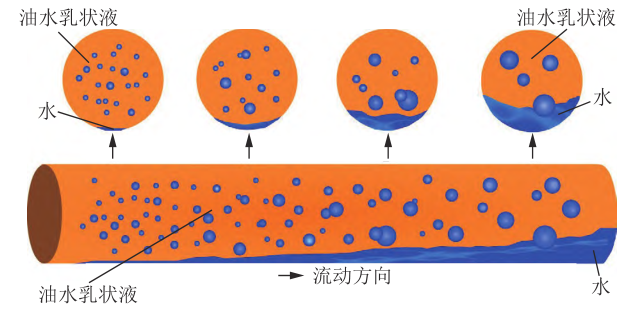
Figure 7 Schematic diagram of axial and circumferential oil-water distribution changes in heavy oil mixed transportation pipelines
Key breakthroughs have been made in the design technology of submarine pipeline structures under harsh sea conditions and hazardous geology. The complex fluid structure coupling analysis theory of "wave flow pipeline soil" has been further developed (Figure 8), and a series of new technologies such as the stability design technology of submarine pipelines on sloping seabed have been successfully developed and applied. In the development of the Liwan gas field in the South China Sea, an analysis and suppression method for cross erosion of submarine pipelines in a strong jet environment was proposed, which solved the stability design and erosion suppression problems of large slope submarine pipelines, broke through the construction prohibition zone of submarine continental shelf steep slope pipelines, supported the expansion of oil and gas field development from shallow sea to deep sea, and solved the technical problems of pipeline structure safety and integrity in harsh environments.
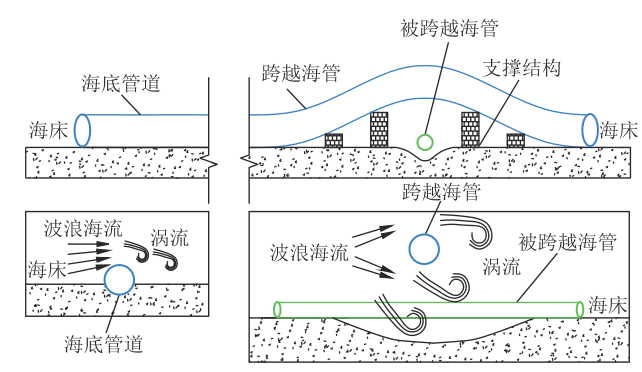
Figure 8 Analysis model diagram of cross erosion of submarine pipelines under the combined action of waves and currents
Through more than 20 years of continuous development and construction, China has established a system of submarine oil and gas pipeline installation technology and engineering equipment. It has developed and formed various types of submarine pipeline laying technologies based on dynamic positioning ship, anchor mooring ship, etc., and developed a series of large-scale special engineering construction ships and equipment such as Offshore Oil 201 Ship, Offshore Oil 286 Ship, and combined them to form an industrial engineering system. In the rolling development project of the Pingbei Huangyan oil and gas field, the deep-water backpack tied pipeline laying technology was proposed, and a dedicated pipe clamp for double pipe laying and an adaptive torsion suppression device were invented and successfully applied in engineering. At present, the positioning accuracy of China's kilometer level water depth pipelines has reached 0.3%, and a significant breakthrough has been achieved in the laying of submarine pipelines from 300m to 1500m (Figure 9), forming China's ability to lay submarine pipelines throughout the sea area.
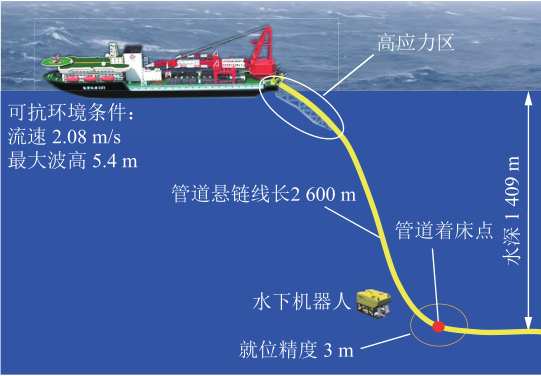
Figure 9 Deep water high-precision submarine pipeline laying model diagram
The emergency response and maintenance system for China's underwater oil and gas pipeline accidents has been comprehensively constructed and improved. A series of innovative inventions and equipment for accident handling, maintenance, and protection, such as deep seabed excavators and gravity atmospheric dry tanks, have been introduced and successfully applied. A series of national construction methods and standard systems for underwater pipeline maintenance have been established and formed. In the non-stop construction of the Bohai Cross Channel Submarine Pipeline, the technical problem of the in-service pipeline lying 4.5m underground under hard seabed conditions was solved, effectively protecting the cross channel submarine pipeline (Figure 10). Effective breakthroughs have been made in key technologies and equipment such as emergency sealing of leaked submarine pipelines, wet underwater non-stop repair, and deep water plow trenching, and have been applied in engineering, achieving rapid disposal of submarine pipeline accidents in China's entire sea area. In the past decade, China has successfully dealt with 31 incidents of damage to various underwater pipelines, effectively protecting the marine ecological environment.
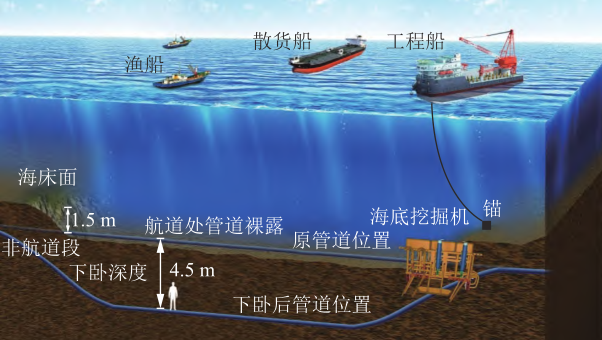
Figure 10: Model diagram of overall underground construction of in-service pipelines across waterways without stopping production
2. Trends in Engineering Technology Development
At present, there is still a significant gap between China's submarine pipeline engineering technology and equipment system and the international leading level, and it cannot fully meet the development requirements of domestic and foreign offshore oil and gas fields. Especially in the fields of ultra deep water riser engineering technology, large-scale construction equipment and tools, core materials, there are still significant shortcomings that need to be further broken through and developed to achieve comprehensive independent mastery and technological catch-up, laying a solid foundation for accelerating the development of offshore and ultra deep water oil and gas fields in the South China Sea.
⑴ Ultra deep water submarine pipeline engineering technology
Further development and deepening of ultra deep water flow safety protection technologies, such as underwater gathering and transportation treatment, underwater pressurization, underwater separation and flow control, and flow safety protection, are still needed to achieve engineering applications. The engineering technology of ultra deep water riser structures also urgently needs to be comprehensively mastered, including independent research and capability improvement in anti fatigue design, installation dynamic analysis, in-service inspection and safety assessment, maintenance and emergency repair, and other technologies.
⑵ Construction equipment system for deep-water subsea pipelines
At present, China has over a hundred sets of large-scale underwater pipeline engineering equipment and tools, including dynamic positioning S-shaped laying ships, anchor S-shaped laying ships, flexible pipeline laying ships, submersible support ships (DSVs), underwater robots (ROVs) jet trenchers, plow trenchers, etc. However, the related equipment and equipment capabilities cannot fully meet the requirements of deepwater oil and gas field development, and their equipment capabilities need to be further upgraded. In addition, there is still room for further breakthroughs in key technologies and the development and application of related engineering equipment and tools, such as J-lay laying ships, Reel lay laying ships, and emergency wet recovery devices for deep-water subsea pipelines.
Research and development of key core materials and performance improvement
Due to the technological shortcomings in basic research and industrialization, there is still a significant gap in the performance of China's key core materials compared to the international leading level. Specifically, in the subsea pipeline industry, it is necessary to further strengthen external cooperation, increase research and development investment and technological breakthroughs, and achieve comprehensive and continuous improvement in the performance of domestically produced materials for steel pipes, welding materials, key structural materials, and key components of flexible marine hoses, in order to better match the usage requirements of ultra deep water, harsh environments, complex working conditions, and loads.
5、 Conclusion
In recent years, China's investment in offshore oil extraction has significantly increased, and China's offshore oil extraction and exploration industry is also rapidly developing, creating good development prospects and opportunities for China's submarine pipeline engineering. Submarine pipelines are an inevitable choice for the development of offshore oil and gas fields. It is of great significance to comprehensively and independently master various types of submarine pipeline design, construction, installation, maintenance and repair, disposal and recovery technologies, and carry out domestic research on supporting technologies and equipment, forming engineering capabilities with independent intellectual property rights, for the comprehensive promotion of China's offshore oil and gas field development and construction.
At present, China has overcome major challenges such as long-distance multiphase transportation of heavy oil and high pour point oil, design and construction in complex seabed geology and harsh marine environments, and emergency response to offshore oil and gas pipeline accidents. It has established a relatively complete submarine pipeline engineering technology and equipment system, achieved a major breakthrough in laying submarine pipelines from 300m to 1500m in depth, formed China's entire sea area submarine pipeline engineering capacity and industrial system, promoted the large-scale development of China's offshore oil and gas fields, and achieved the same international level of related technology and equipment capabilities.
[The article was reprinted on WeChat official account - Stream Ocean Life 2022-11-17]
High-end pipe manufacturing equipment
manufacturing experience
professional team
Plant a total area of 10,000
square meters
9 inventions, 11 utility models <bR />2 appearance designs
2016-2019 © Huajin Heavy Equipment All Rights Reserved Xiang ICP Preparation 12002607 Number